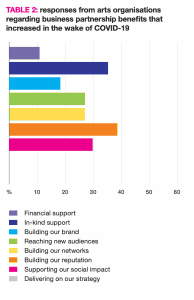Reimagining for-purpose partnerships: learning from the arts and culture sector
Whether you’re a leader in the not-for-profit, government, education or commercial sectors, you will no doubt currently be grappling with more existential and operational questions than usual. Covid-19 reshaped our world and continues to change how we live. Organisations in Australia’s $112 billion arts and culture sector were among the hardest hit, with the live performance industry suffering the most. At the same time, for-profit businesses of all sizes were forced to interrogate the fundamentals of their operations as their ecosystems including supply chains, partnerships and customer expectations were disrupted beyond recognition.
Spark Strategy released a white paper with Creative Partnerships Australia and Arts Centre Melbourne that examined arts and culture sector resilience through the lens of evolving partnerships models. No one will be surprised to learn that a key trend uncovered in the research was declining financial support through traditional sponsorship models. However, what emerged as a result of greater financial uncertainty and hardship was fascinating. We’ve taken key insights and translated them into actionable tips to help organisations in all sectors navigate the journey towards partnering for growth and greater collective impact.
Through conversations with arts industry representatives and other stakeholders, we uncovered two key insights:

2. There was a shift occurring towards recognition of the value of creative capital, including creative skills and services.
This learning is particularly relevant as we see the arts and culture sector receive boosts in federal and state funding, with focus on innovating their value propositions and business models to remain relevant. For organisations navigating these shifts, particularly those that are small-to-medium sized, the question is how they can leverage partnerships more creatively. Moreover, the question is likely “how can we do that whilst managing business as usual and position ourselves for long-term sustainability?”
In this blog, we’ve pulled together key insights, learning and tips to support organisations across all sectors as they grapple with questions around partnering for impact, resilience and long-term sustainability.
Position your partnerships centre-stage
The key to successfully navigating the changing external environment and coming out stronger is to avoid the common pitfall of seeing partnerships as an add-on as opposed to a key element of your overall strategy. This is a point Siobhan Kranz, Partnerships Manager at Arts Centre Melbourne can’t emphasise enough, agreeing that “Partnerships aren’t just a bolt-on. They’re an opportunity to work collaboratively with other organisations to drive your strategic direction.” This largely comes down to getting internal buy-in and socialising the strategy so that partnerships are considered through all layers of the organisation as an integral driver of value. Siobhan adds that “Partnerships are strongest when there’s buy-in across the organisation – where the purpose of the partnership is understood and embraced at all levels.”
Think big, start small
In an environment where corporates are shifting towards brand promises that incorporate social and environmental impact, it’s important to consider potential for partnerships that move beyond the transactional to the transformative. As Siobhan explains, “Corporations are much more sophisticated now. Stakeholders are evolving and investing in partnerships that are impact centred. Now it’s about answering the question: how can we make the world a better place together?” For smaller organisations, starting small is key; forging more traditional value exchanges is fine to get your foot in the door, but you should treat the beginning of a partnership as the start of an ongoing, values-aligned conversation about how you can grow together to deliver more mutual value and greater impact to the community.
Avoid reinventing the wheel
Chances are, your organisation already has partnerships in place with potential to grow, or there may be opportunities to reignite conversations to ascertain new priorities. Conduct an inventory of your current and prospective partners and think about ways to re-engage around mutually beneficial strategies. Siobhan agrees this can happen as an organic process provided you know your updated value proposition, and that “…where resources are scarce it’s a great first step to look at existing networks. A strategic partnership may be the natural next step for a relationship that already exists.” It’s vital to explore how to steadily build long-term value into your organisation’s DNA, and for some this may mean investing in slow-burn, high-return relationships with staying power.
Expand your definition of value
In the white paper we highlighted case studies from organisations that have succeeded in bottling their creative capital as a fresh value-add in existing partnerships. The extended partnership between Belle Shakespeare and King & Wood Mallesons is a great example of a cross-sector partnership that has been developed collaboratively to boost resilience as both organisations have weathered the pandemic.
Build mutual capabilities
Being multi-layered in your approach can mean figuring out where your respective capability gaps are and developing innovative ways to fill them. Chances are, if there’s something you don’t yet have internal capacity to do, a corporate or other partner may be able to help in exchange for something that adds value for them. This could look like offering a corporate partner creative capital in the form of arts-based training (think online facilitation coaching that draws on acting skills) in exchange for IT or leadership development support.
Future approaches to multi-layered partnerships need to be strategic and impact-focused. As Siobhan puts it, “Partnerships are an exercise in matchmaking. It’s about understanding the needs of each organisation and the difference they want to make in the world. From there you can design solutions and value based on each partner’s unique capabilities. Matt Morse, Executive Director, Strategy & Programs at Creative Partnerships Australia, adds that “There is much advocacy work to be done to cement the value of arts-based partnerships, especially in the context of value-add for consumer brands, to realise the potential benefits of aligning for social and environmental good”. Siobhan agrees, adding that, “…with enhanced collaboration comes more diverse thinking, better results and greater impact”.
If you’ve got learning to share about partnering for impact or would like to discuss your partnerships strategy, we’d love to hear from you! Feel free to get in touch here.




0 Comments